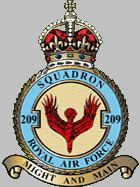Motto(s) Might and Main | ||
 | ||
Active 1 February 1917 (RNAS) – 24 June 191915 January 1930 – 1 January 19551 November 1958 – 31 December 1968 Role Squadron Badge heraldry An eagle volant recursant descendant in pale, wings overture | ||
No. 209 Squadron of the British Royal Air Force was originally formed from a nucleus of "Naval Eight" on 1 February 1917 at Saint-Pol-sur-Mer, France, as No. 9 Squadron Royal Naval Air Service (RNAS) and saw active service in both World Wars, the Korean War and in Malaya. The use of the squadron number ceased in 1968 and has not been reused since by an RAF squadron.
Contents
- Formation and World War I
- The interbellum
- World War II
- Hong Kong and Seletar
- To Korea
- With Pioneers in the transport role
- Notable personnel
- References
However the number, Crest and motto is in current service within the RAF Air Cadets at 209 (West Bridgford) Squadron ATC in Nottinghamshire.
Formation and World War I
The Squadron was formed as a Royal Air Force Squadron on 1 April 1918, from No. 9 Squadron, Royal Naval Air Service at Clairmarais. (All former RNAS squadrons were renumbered by the addition of 200 to their RNAS number.) During the remainder of World War I, 209 Squadron flew Sopwith Camels over the Western Front on fighter and ground support missions. The Squadron badge, the falling eagle, symbolizes the destruction of Baron Manfred von Richthofen who, in the 1914–1918 War, was credited to the guns of a pilot, Roy Brown from No. 209 Squadron. On 21 January 1919, the squadron was reduced to a skeleton organization and disbanded in the UK on 24 June 1919 at RAF Scopwick, Lincolnshire.
The interbellum
No. 209 reformed at the flying boat base at RAF Mount Batten, Plymouth on 15 January 1930. It was first equipped with Blackburn Iris flying boats and then from January 1934 by Blackburn Perth but neither of these types were built in sufficient quantities to equip the squadron fully. In July 1936, however, the squadron was fully equipped with Short Singapore Mk.IIIs and it was transferred to RAF Kalafrana, Malta in September 1937 for three months. In December 1938, No 209 began to convert to yet another flying boat type, the Supermarine Stranraer.
World War II
When the Second World War broke out, No.209 moved to Invergordon to patrol the North Sea between Scotland and Norway. From October 1939 it patrolled the Atlantic from Oban. Two further re-equipments occurred, in December 1939 (Saro Lerwicks) and then in April 1941 (Consolidated Catalinas). Familiarisation with the U.S. supplied Catalinas was aided by the secondment of U.S. military personnel who also flew on active service patrols, despite the U.S. being a neutral power at the time. Anti-submarine patrols were flown over the Atlantic from RAF Castle Archdale on Lough Erne, in Northern Ireland, using the Donegal Corridor over neutral Eire. During this time, in May 1941, a patrol by No.209 (with an American crewman) located the German battleship Bismarck.
In August 1941, the squadron moved to Iceland for two months. From March 1942 until July 1945, No.209 was stationed in East Africa. It flew patrols over the Indian Ocean with detached bases in South Africa, Madagascar, Oman and the Seychelles to extend its cover. In July 1945 the squadron moved to Ceylon (now Sri Lanka), with recently acquired Short Sunderland MkVs, with a detachment at Rangoon (now Yangon), to harass Japanese shipping along the coast from Burma (now Myanmar) to Malaya.
Hong Kong and Seletar
After the Japanese surrender in August 1945, a detachment was sent to Hong Kong in September, followed by the rest of the squadron in October. In April 1946 the squadron moved to Singapore. A detachment remained at RAF Kai Tak and became No.1430 flight and then No.88 Squadron. The squadron headquarters was established at RAF Seletar (sometimes referred to as "Seltar"), on Singapore Island on 18 May 1946 and No.209 and was named "City of Hong Kong" Squadron on 23 January 1947.
To Korea
Operation Firedog missions during the Malayan Emergency began on 7 July 1948. In September 1950, during the Korean War, the aircraft were moved to Iwakuni, Yamaguchi, Japan to patrol off the Korean coast from 15 September. On 1 January 1955 the squadron merged with No. 205 Squadron.
Currently
209 is still in use today with the Air Cadet Organisation. 209 (West Bridgford) Squadron Air Training Corp in Nottinghamshire have taken over the old Squadron Number and Crest.
The Squadron itself has a great history and is currently a strong and active unit.
With Pioneers in the transport role
On 1 November 1958 No. 267 Squadron at RAF Kuala Lumpur was renumbered 209 Squadron and flew Scottish Aviation Pioneers and Scottish Aviation Twin Pioneers on liaison and transport duties in Malaysia. No.209 Squadron was finally disbanded on 31 December 1968 at RAF Seletar.
